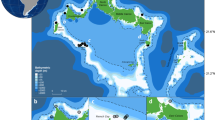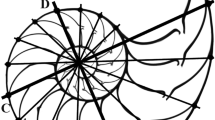Abstract
Rhabdom morphology in oplophorid shrimps varies both interspecifically and also within the eye of an individual, particularly with respect to the relative sizes of distal and proximal rhabdoms. We have combined published data on anatomical measurements, visual pigment absorption, and underwater light distribution to model the absorptance of light from different sources by the rhabdoms in these shrimps. In Systellaspis debilis the violet-sensitive distal rhabdom is prominent and increases in size along a dorso-ventral gradient. The model shows that the dorsal ommatidia are efficient at detecting downwelling irradiance and photophore emissions. In more ventral regions of the eye, the enlarged distal rhabdom results in the ommatidia in this region being more sensitive to eyeshine from other shrimps and to their bioluminescent secretions. This will improve the contrast of such light sources against the background space light. Acanthephyra pelagica has virtually no distal rhabdom and the model shows that this arrangement results in greater sensitivity.



Similar content being viewed by others
References
Bayliss LE, Lythgoe JN, Tansley K (1936) Some forms of visual purple in sea fishes with a note on the visual cells of origin. Proc R Soc Lond B 120:95–114
Clarke RL (1936) On the depths at which fishes can see. Ecology 17:452–456
Cronin TW, Frank TM (1996) A short-wavelength photoreceptor class in a deep-sea shrimp. Proc R Soc Lond B 263:861–865
Denton EJ (1990) Light and vision at depths greater than 200 metres. In: Herring PJ, Campbell AK, Whitfield M, Maddock L (eds) Light and life in the sea. Cambridge University Press, Cambridge, pp 127–148
Frank TM, Case JF (1988) Visual spectral sensitivities of bioluminescent deep-sea crustaceans. Biol Bull (Woods Hole) 175:261–273
Frank TM, Widder EA (1994a) Evidence for behavioural sensitivity to near-UV light in the deep-sea crustacean Systellaspis debilis. Mar Biol 118:279–284
Frank TM, Widder EA (1994b) Comparative study of behavioral-sensitivity thresholds to near-UV and blue-green light in deep-sea crustaceans. Mar Biol 121:229–235
Frank TM, Widder EA (1996) UV light in the deep-sea: in situ measurements of downwelling irradiance in relation to the visual threshold sensitivity of UV-sensitive crustaceans. Mar Freshw Behav Physiol 27:189–197
Gaten E, Shelton PMJ, Herring PJ (1992) Regional morphological variations in the compound eyes of mesopelagic decapods in relation to their habitat. J Mar Biol Assoc UK 72:61–75
Gaten E, Herring PJ, Shelton PMJ (2002) Eye morphology and optics of the double-eyed mysid Euchaetomera typica. Acta Zool 83:221–230
Gaten E, Shelton PMJ, Nowel MS (2003) Interspecific variations in the morphology and ultrastructure of the rhabdoms of oplophorid shrimps. J Morphol 257:87–95
Herring PJ (1983) The spectral characteristics of luminous marine organisms. Proc R Soc Lond B 220:183–217
Hiller-Adams P, Widder EA, Case JF (1988) The visual pigments of four deep-sea crustacean species. J Comp Physiol 163:63–72
Kampa EM (1970) Underwater daylight and moonlight measurements in the eastern North Atlantic. J Mar Biol Assoc UK 50:397–420
Kent J (1997) The visual pigments of deep-sea crustaceans. PhD thesis, University of Bristol
Kirk JTO (1983) Light and photosynthesis in aquatic ecosystems. Cambridge University Press, Cambridge
Land MF (1989) The eyes of hyperiid amphipods: relations of optical structure to depth. J Comp Physiol 164:751–762
Land MF (2000) On the function of double eyes in midwater animals. Philos Trans R Soc Lond B 355:1147–1150
Land MF, Burton FA, Meyer-Rochow VB (1979) The optical geometry of euphausiid eyes. J Comp Physiol 130:49–62
Laughlin SB (1981) Neural principles in the peripheral visual systems of invertebrates. In: Autrum H (ed) Handbook of sensory physiology, vol VII/6B. Springer, Berlin Heidelberg New York, pp 133–280
Lythgoe JN (1968) Visual pigments and visual range under water. Vis Res 8:977–1012
Lythgoe JN (1979) The ecology of vision. Clarendon Press, Oxford
Nässel DR (1976) The retina and retinal projection on the lamina ganglionaris of the crayfish Pacifastacus leniusculus Dana. J Comp Neurol 167:341–360
Nowel MS, Shelton PMJ, Herring PJ (1998) Cuticular photophores of two decapod crustaceans, Oplophorus spinosus and Systellaspis debilis. Biol Bull (Woods Hole) 195:290–307
Partridge JC, Archer SN, Lythgoe JN (1988) Visual pigments in the individual rods of deep-sea fishes. J Comp Physiol 162:543–550
Shelton PMJ, Gaten E, Herring PJ (1992) Adaptations of tapeta in the eyes of mesopelagic decapod shrimps to match the oceanic irradiance distribution. J Mar Biol Assoc UK 72:77–88
Shelton PMJ, Gaten E, Johnson ML, Herring PJ (2000) The ‘eye-blink’ response of mesopelagic Natantia, eyeshine patterns and the escape reaction. Crustac Issues 12:253–260
Stavenga DG, Smits RP, Hoenders BJ (1993) Simple exponential functions describing the absorbance bands of visual pigment spectra. Vis Res 33:1011–1017
Tyler JE, Smith RC (1970) Measurements of spectral irradiance underwater. Gordon and Breach, New York
Wald G, Rayport S (1977) Vision in annelid worms. Science 196:1434–1439
Warrant EJ, Nilsson D-E (1998) Absorption of white light in photoreceptors. Vis Res 38:195–207
Welsh JH, Chace FA (1937) Eyes of deep-sea crustaceans. Acanthephyridae. Biol Bull (Woods Hole) 72:57–74
Welsh JH, Chace FA (1938) Eyes of deep-sea crustaceans. Sergestidae. Biol Bull (Woods Hole) 74:364–375
Acknowledgements
This work was supported by NERC grant GR3/11212. MSN gratefully acknowledges sabbatical support from Providence College. We would like to thank Justin Marshall (University of Queensland) for making available his data on the reflectance of carapace and tapetum of S. debilis. We thank Magnus Johnson for his valuable comments on an earlier draft of the manuscript.
Author information
Authors and Affiliations
Corresponding author
Additional information
Communicated by J.P. Thorpe, Port Erin
Rights and permissions
About this article
Cite this article
Gaten, E., Shelton, P.M.J. & Nowel, M.S. Contrast enhancement through structural variations in the rhabdoms of oplophorid shrimps. Marine Biology 145, 499–504 (2004). https://doi.org/10.1007/s00227-004-1338-2
Received:
Accepted:
Published:
Issue Date:
DOI: https://doi.org/10.1007/s00227-004-1338-2




